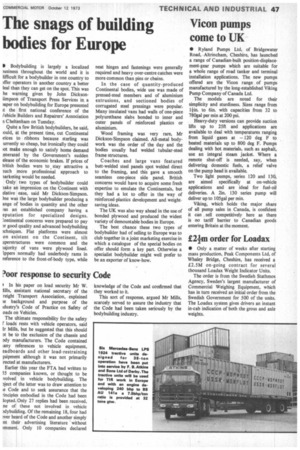The snags of building bodies for Europe
Page 45

If you've noticed an error in this article please click here to report it so we can fix it.
D Bodybuilding is largely a localized msiness throughout the world and it is lifficult for a bodybuilder in one country to iffer operators in another country a better leal than they can get on the spot. This was he warning given by John Dicksoniimpson of Transport Press Services in. a )aper on bodybuilding for Europe presented it the first national conference of the /thick Builders and Repairers' Association n Cheltenham on Tuesday.
Quite a few British bodybuilders, he said, ould, at the present time, cut Continental It-ices to ribbons because sterling was urrently so cheap, but ironically they could lot make enough to satisfy home demand enerated by the Government's sudden elease of the economic brakes. If prices of Iritish bodies were to stay attractive a luch more professional approach to iarketing would be needed.
Only two types of bodybuilder could -lake an impression on the Continent with elative ease, said Mr Dickson-Simpson. )ne was the large bodybuilder producing a ange of bodies in quantity and the other /as an established company having a eputation for specialized designs. :ontinental concerns were prepared to pay )r. good quality and advanced bodybuilding ;chniques. Flat platforms were almost on existent on the Continent, tilt aperstructures were common and the tajority of vans were plywood lined. ippers normally had underbody rams in reference to the front-of-body type. while
neat hinges and fastenings were generally required and heavy over-centre catches were more common than pins or chains.
In the case of quantity-produced Continental bodies, wide use was made of pressed-steel members and of aluminium extrusions, and sectioned bodies of corrugated steel pressings were popular. Many insulated vans had walls of one-piece polyurethane slabs bonded to inner and outer panels of reinforced plastics or aluminium.
Wood framing was very rare, Mr Dickson-Simpson claimed. All-metal bodywork was the order of the day and the bodies usually had welded tubular-steel frame structures.
Coaches and large vans featured butt-welded steel panels spot welded direct to the framing, and this gave a smooth seamless one-piece side panel. British concerns would have to acquire some fresh expertise to emulate the Continentals, but they had a lot to offer in the way of reinforced-plastics development and weightsaving ideas.
The UK was also way ahead in the use of bonded plywood and produced the widest variety of demountable bodies in Europe.
The best chance these two types of bodybuilder had of selling to Europe was to club together in a joint marketing exercise in which a catalogue of the special bodies on offer should form a key part. Otherwise a specialist bodybuilder might well prefer to be an exporter of know-how.




















































































































